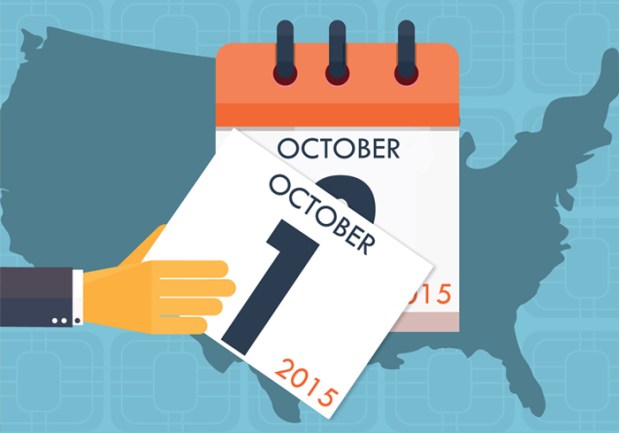EMV Day 1: The Experts Weigh In

Ready or not, the EMV liability shift is here. So which is it – ready? Or not? PYMNTS decided to ask the experts. Some 15 players with power across the EMV ecosystem – the card networks, the issuers, the acquirers, the processors and the technologists – gave us their report card on the progress we as an industry have made so far, and their best guesses on what Day 366 will look like, too. Ready to get past the fluff, and down to the facts?
The clock has officially run out.
As of today, retailers and businesses are either ready to take chip-enabled credit cards, or they will be liable in the event of card-present card fraud if they accept transactions made with EMV cards and don’t have EMV terminals – or vice versa.
The run-up has not exactly been smooth. As of early September, just a month out, about 44 percent of large businesses (those with over 500 employees) were EMV-ready, while a majority of small businesses – 64 percent – are not. And the enthusiasm among businesses owners (particularly in some segments) has been lacking.
“We haven’t [updated for EMV]. And, in the restaurant industry in general, the motivation has been lacking to do that update,” Eric Rosenzweig, Chief Information Officer at Garden Fresh Restaurant Corp., told MPD CEO Karen Webster in a recent discussion. “While the shift of liability is coming in October for those of us in the restaurant business, we have a very low chargeback and fraud rate we’ve seen over the years. That shift in liability does not mean that much to us. To make an investment in refreshing tons of terminals, we have to be pretty sure it is something that is going to work, improve business and continue to work for a very long time.”
The good news, sort of, is that those non-converted businesses owners probably won’t be dealing with a rush of consumers itching to trial run their chip cards in the very near future, since according to recent reports almost 60 percent of all American consumers don’t actually have an EMV card just yet.
Be all that as it may, ready or not, EMV has come.
However, the question remains even today: Are we more ready, or more not?
While there will be a lot of hype, spin and buzz today, real answers will be in short supply. Lucky for our readers, PYMNTS started looking for those real answers well before today. We brought together 15 of the best and brightest minds in the EMV ecosystem to talk about the issues from all sides, rank the progress so far and outline what they think the progress — and potential — for EMV going forward will look like. And we do mean all sides — issuers, acquirers, card network, technologist, mobile players and processors.
So what did the experts think?
The progress so far got less than a stunning vote of confidence. We asked all our participants:
“How would you grade our performance as an ecosystem so far: Exemplary, Satisfactory, Performance Improvement Needed, or Failing Grade – and why?”
There was one “Exemplary” a few “Satisfactories” and a lot of ““Performance Improvement Needed,” bring the rough average score to about a C.
That “Exemplary” grade came from MasterCard’s Head of Product Delivery Carolyn Balfany, who also noted “ It is an exciting time to be in the payments. The industry is innovating – chip cards, phone payments, tap-and-go – at the same time it is becoming safer and more secure. That is a rarity.”
Forte’s CEO Jeff Thorness was somewhat less excited about the progress with his “Needs Improvement” ranking.
“There hasn’t been nearly enough awareness or education provided to the various participants. Many merchants still do not understand the liability shift and do not have a migration plan established for their card services,” he said.
And while there was a variety of opinions on the journey so far — and what the biggest difficulties ahead will be — there was also a lot of optimism for EMV and what it opens the door for going forward.
“In a broader context, the underlying EMV infrastructure for secure payments already forms the basis for several innovations: contactless (EMV) cards, mobile NFC payments based on both the secure element model for Apple Pay and Samsung Pay, and cloud-based payments for Android mobile NFC phones — and also in using the EMV cryptogram in securing payment and authentication in eCommerce,” noted David Thomas Worthington, Principal Consultant, Payments and Chip Technology, Bell ID.
Need to know more? Worried about what comes next? Still trying to figure out the ins-and-outs of EMV? Totally confused about how The Durbin Amendment and debit ties into all this to create “an incomprehensible spaghetti-like mess?”
Well then it looks like you need to download the whole PYMNTS e-book.
It’s free, it’s fun and it’s guaranteed to make you the most informed person at all of your cocktail and tailgate parties this weekend.
To download the e-book ” Day 1: EMV in the U.S. – Current State and What’s Next” please click the button below…

